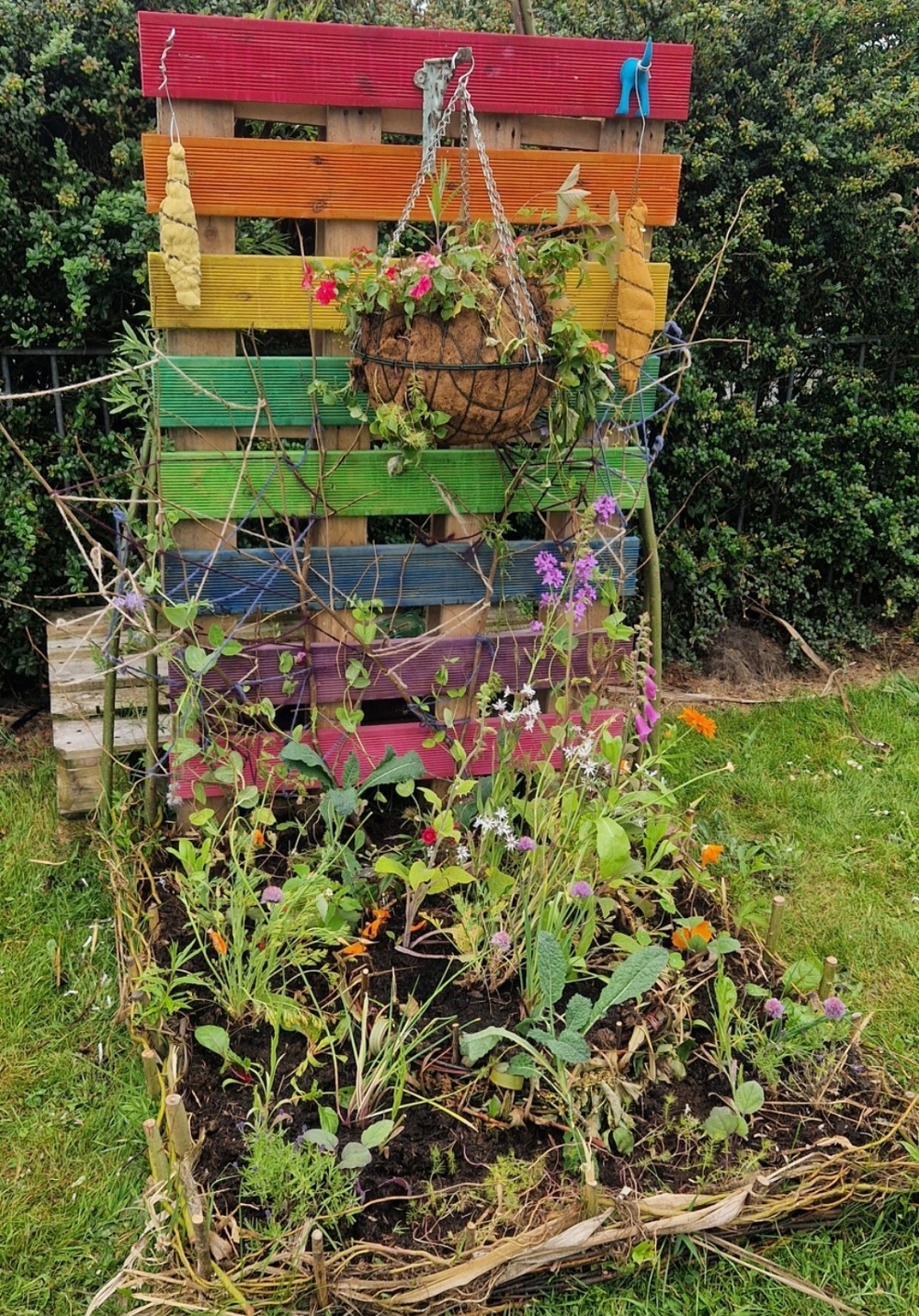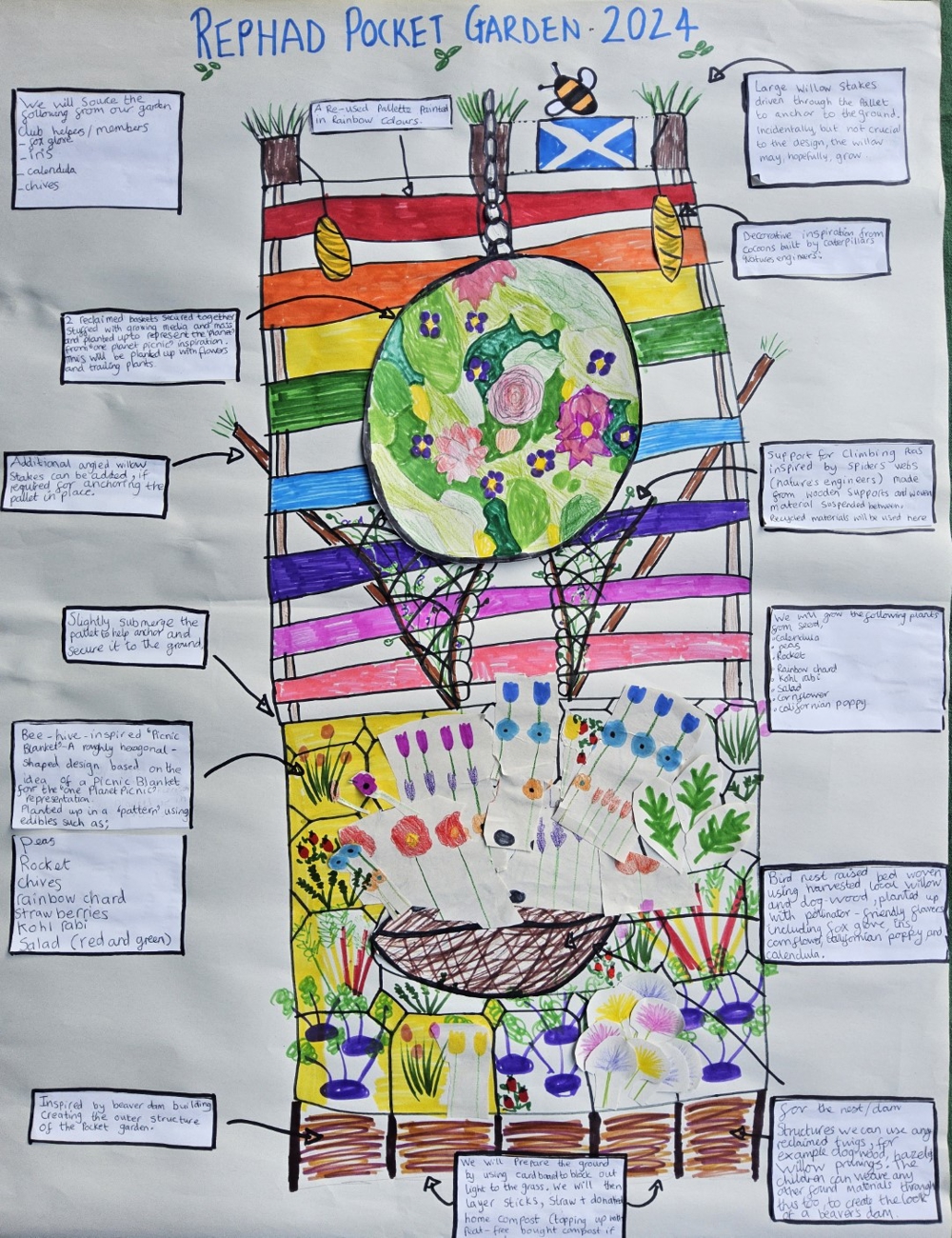Rephad Primary
Rephad Primary

Nature’s engineers have been represented in our pocket garden in several ways. Firstly, the structure around the garden is constructed like a Beaver would build a dam, only we have used it to frame the pocket garden. The raised circular bed in the middle of the garden is inspired by a bird’s nest, and we have decorated our garden with cocoons inspired by caterpillars making their transitional home, and have copied the idea of spiders webs to create a frame for our peas to grow up.
Designing the garden was great fun for all the children involved. It was interesting seeing the various ideas on paper at the beginning slowly transform into an actual design. At one point I think we thought we had been a little ambitious with our design, but with some inventive thinking solutions were soon found to problems.
There have been so many lessons to learn in the creation of this pocket garden. The first is that time goes much quicker than you could ever imagine! The second is that children have such wonderful imaginations, and we should embrace that. Thirdly, it is difficult to get your plants to a good maturity in a short time. Fourthly, it is great to have friends with a polytunnel who are willing to help out in the holidays with your precious seedlings!
For some children I think their favorite part was drawing the design. We have one very talented artist in the gardening club and they absolutely loved putting the design together and making it colourful. Others really enjoyed sowing seeds and watering (or just getting dirty!). It is such a simple activity to do, but the enthusiasm was contagious and enchanting. The sheer joy the children got making their design become reality made it all a thoroughly worthwhile project.
We had a couple of plants that either didn’t germinate (edible pansies) or had finished flowering by the time we were planting up our garden (herbaceous iris), so we substituted them with other plants. Also, some plants really didn’t grow as quickly or as big as we ideally would have liked them to look for the showcase, but we are all still very pleased with the garden and it makes everyone smile.
After the showcase has been completed we will continue to look after the garden for the pollinators and we will grow the edible food until it is ready to harvest. It is located just inside the main entrance to the school, so it is very visible, and we wish to keep it looking nice. We may eventually plant it up purely with flowers to attract pollinators, as we have raised beds elsewhere in the school for growing edibles.
Our gardening club has only been running for just over a year, and we are all learning from each other. It has been good fun to be involved in this pocket garden competition, as it has given us a focus for some of our activities. We only meet once a week for just over an hour, so we feel very proud of what the children have been able to achieve. The competition encouraged us to start the club up earlier than we would have otherwise done so this year, which has been really positive in many ways, not least making us realise we would really like to have a polytunnel of our own.
Our gardening club is run by volunteers. and funded by the school’s Parent Council, and donations. The local Community garden donated some plants and compost, as well as a plant nursery near Newton Stewart who kindly donated 2 plants when they heard what we were doing. We have some older children in the school who have been helping mentor the younger children in the club, and they help them with various activities.
Our garden is attractive to wildlife because we have used many plants that will attract pollinators, as well as maybe the odd pigeon! We have not used any chemicals or peat based products and have tried to grow as much of our produce from seed as possible. We were donated the busy lizzies used in the ‘planet’ which is representative of the idea of a ‘one planet picnic’, so food for pollinators and humans.
We have edible plants such as Cavolo nero, lettuce, chives, strawberries, rainbow chard, kohl rabi, peas, and nasturtium. We have attracted pollinators with the use of plants such as fox gloves, calendula, poppies, nigella, phacelia tanacetifolia, lavender, dianthus and hesperis.
We were able to use an unwanted pallet, some wood that was no longer needed by the school to paint as the rainbow background, cardboard to line the base of the raised bed, followed by donated sheep wool, old straw, shredded paper, home-made compost (topped up with some bought peat-free compost). Two of the hanging brackets were re-used, and all of the willow, hazel, contorted willow, phormium leaves etc used for weaving the birds nest and beaver dam were all donated by a gardener in the school community or found in the school grounds.


